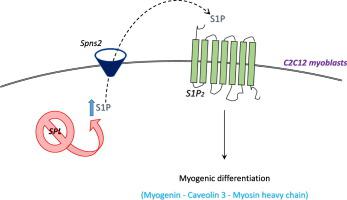Biochimica et Biophysica Acta (BBA) - Molecular and Cell Biology of Lipids ( IF 3.9 ) Pub Date : 2020-06-19 , DOI: 10.1016/j.bbalip.2020.158759 Francesca Cencetti 1 , Gennaro Bruno 2 , Caterina Bernacchioni 1 , Lukasz Japtok 3 , Elisa Puliti 1 , Chiara Donati 1 , Paola Bruni 1

|
The bioactive sphingolipid sphingosine 1-phosphate (S1P) has emerged in the last three decades as main regulator of key cellular processes including cell proliferation, survival, migration and differentiation. A crucial role for this sphingolipid has been recognized in skeletal muscle cell biology both in vitro and in vivo. S1P lyase (SPL) is responsible for the irreversible degradation of S1P and together with sphingosine kinases, the S1P producing enzymes, regulates cellular S1P levels. In this study is clearly showed that the blockade of SPL by pharmacological or RNA interference approaches induces myogenic differentiation of C2C12 myoblasts. Moreover, down-regulation of the specific S1P transporter spinster homolog 2 (Spns2) abrogates myogenic differentiation brought about by SPL inhibition or down-regulation, pointing at a role of extracellular S1P in the pro-myogenic action induced by SPL blockade. Furthermore, also S1P2 receptor down-regulation was found to abrogate the pro-myogenic effect of SPL blockade. These results provide further proof that inside-out S1P signaling is critically implicated in skeletal muscle biology and provide support to the concept that the specific targeting of SPL could represent an exploitable strategy to treat skeletal muscle disorders.
中文翻译:

鞘氨醇1-磷酸裂合酶的阻断引起鼠成肌细胞通过Spns2 / S1P2受体轴起作用的成肌分化。
在过去的三十年中,具有生物活性的鞘脂鞘氨醇1-磷酸(S1P)作为关键细胞过程(包括细胞增殖,存活,迁移和分化)的主要调节剂出现了。鞘脂的这一关键作用已在体外和体内骨骼肌细胞生物学中得到认可。S1P裂解酶(SPL)负责S1P的不可逆降解,并与鞘氨醇激酶(产生S1P的酶)一起调节细胞S1P的水平。在这项研究中清楚地表明,通过药理或RNA干扰方法阻断SPL会诱导C2C12成肌细胞发生肌源性分化。此外,特定S1P转运蛋白spinster同源物2(Spns2)的下调取消了SPL抑制或下调所带来的肌源性分化,指出了细胞外S1P在SPL阻断诱导的促肌原性作用中的作用。此外,S1P 2发现受体下调消除了SPL阻断的促肌原作用。这些结果进一步证明了由内而外的S1P信号传导与骨骼肌生物学密切相关,并为SPL的特异性靶向可以代表治疗骨骼肌疾病的可利用策略提供了支持。









































 京公网安备 11010802027423号
京公网安备 11010802027423号